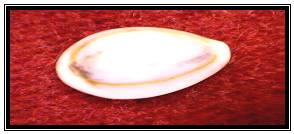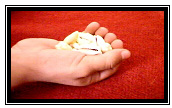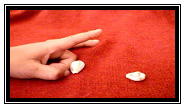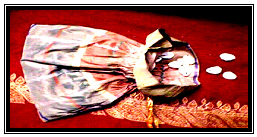Haaran
Gindun: To play with
Haars
Tips of the
game, Rules, Social reverence, New influences,
Daughter’s gift
Literally Haar small molluskan
seashell found in the sea means in Kashmiri the
money or a playing object and a particular game in
Kashmir. An old game that Kashmiri Pandits used to
play on the eve of Maha Shivratri was full of
calculations and entertainment till my childhood
days. Haar (Kaudi in Hindustani) is used in this
play as the main component and the participants
can be from two up to any tolerable limit. There
are rules and regulations, which are to be
followed by the players very strictly, especially
on the day of Salaam the next day after Shivratri
pooja the players gather at one place as this was
one of the finest indoor games known in Kashmir
amongst Kashmiri Pandits. This is almost not in
practice now, but still I remember how we used to
play the game when we were in Srinagar. Full of
fun and enthusiasm, elders, friends and all use to
gather and play this game and the curiosity of
wining the game was a thing of extreme compassion,
love and entertainment.

Description of the
Game
- Haar (The Playing object),
- Chaakh is the measuring unit consists
of four Haar’s,
- Minimum of two Haars to start a game,
- Kunyi (Combination of single Haar
resulting the win),
- Pushraan Dabu (To add a Haar on a
particular number as decided),
- Juph Taaq (Even and Odd combinations:
In this odd numbers were to be won and even
means to pass on the game to next the
player adding a Haar to the rest of Haars on
surface),
- Chaakan (Combination of Four results
the win),
- Duchi (Combination of Two results the
win),
- Shartal means the betting,
- Tichan means to strike with one Haar
another one, usually children play in this
way. These are the various ways of playing.

- Players sit in a circle or opposite to
each other depending on the number of
players.
 
- Botul (Yellowish Haar with
difference) or a Krend Haar (Broken
Haar), Nich Haar (The Small Haar), Vyeth
Haar (The Big Haar) are some other
different shapes of Haar. Different Haars
were used for toss purpose and these were
collected and thrown on the floor. This was
the way to select the player who plays it
first.

Rules of the Game
- All participants who know how to play should
maintain the decorum of the game and have
patience while playing it.
- When agreed to play any particular type of
the game, one should strictly follow the
norms, didn’t mix the tactics of another
form of the play (No cheating please). One can
be disqualified on creating unnecessary
discussions.
- Whosoever should be capable of playing and
posses the Haar in plenty so that one can
play. To own the Haar is important because
Haar is to be lost or won by a player. In our
times we had created a new system of counting
points and at the end all the players were
given their Haars back by repurchase formula.
- The duration of the game as in other games
is never set but it can continue till agreed
duration by the participants.
- Each player should possess a Botul a Haar
with a different look so that one can find it
easily to which player it belongs, which will
be used to decide the first member to start
the game.
- The Botul was also used as Joker in the
cards.
- Plane surface to be used to make a throw of
Haars on the floor.
- A clean sheet of single color also was used
to make counting of Haar’s visible.
- If there are more than two people
participating then a circle was to be formed
and so on.
- In case of two members they use to sit
opposite to each other.
- In case of many participants a bowl was used
to collect the Haars.
- The most competent person only used to count
the Haars thrown on the floor.
- Everything was decided in the beginning of
the game as how and what to do by whom.
- The job was divided amongst few experts who
were assisted by the player and a person
sitting by his or her side.
- This game was strictly played on the eve of
Shivratri locally known as Herath and not on
any other occasion.
Different Ways to play
the Game
- Kunyi: The game was played with the
help of a Haar, which is the only source of
the game. There should be four Haars
compulsory to play it. In this game the Haars
are taken in the hand and thrown on the
surface. Kunyi means a single odd number,
which confirms the win. If one doesn’t get
this formation of numbers no one is declared
the winner. Only if the single Haar is fallen
on the surface upward down or vice versa the
player is declared the winner. All the four or
more Haars, which one throws on the surface,
belong to that particular player. The game
continues likewise till one accepts the defeat
or one is short of Haars.
- Pushraan Dabu: Pushrawun means to
add. Even and odd number of the Haars is
important in determining the play towards
winning. In this type each member contributes
one or more as decided to start the game. With
all these the Haar’s thrown on the surface
are calculated and if the even number of Haars
are upwards down then one has to add to it one
or as decided Haar and thus the game
continues. If one gets three upwards down it
is called to be Chhout meaning ‘no
results’ so it was passed on to another
player. Also if all the Haars fall in their
normal or upward down position in both the
cases it is Chhout meaning no results. In this
too the game is passed on to the another
player. In case of Chhout by Three Haars one
doesn’t have to add anything but pass on to
another player. In case of Chhout by another
means one has to add a Haar or Haar’s as
decided and pass on the game to next player
sitting in a circle in clockwise direction. In
case one gets odd one’s on the surface these
are to be considered won by the particular
player except three Haars. The game is carried
on or if a single Haar is in opposite position
upward down or vice-versa the whole lot of
Haars are won.
- Juph Taaq: (Even and Odd): This is
similar to that of the above mentioned style
but with little difference that is in this odd
numbers were to be won and even means to pass
on the game to next the player adding a Haar
to the Haars on surface. In this there is no
three Haars- no result concept, those
combinations are to be won too. In this only
if all the Haars fell in similar way then only
Chout, no result is considered.
- Chaakan: (Combination of Four results
the win) In this it is decided in the
beginning of the game that only if combination
of four fells on the surface all the Haars are
considered to be won. In this the contribution
of each individual is to be four Haars.
- Duchi: (The Combination of two
decides the win) Similar as above but instead
of four two determines the game. There can be
any number as decided for the game.
- Shartal: (Means the betting) In this
two or more players bet and hide Haars in the
hands the opponent has to tell if there is
even or odd number of Haars which decides the
game.
- Tichan: means to strike one Haar with
another, usually children play in this way.
Two Haars are taken for play each in each
player’s hand. The Haars are kept on the
plane surface and both strike the Haars one by
one and if the Haars are touched the win is
declared. At the end whosoever won the maximum
number is the winner.
- Hu Kus Bu Kus: In this Children first
play a game with the rhyme which is sung and
then hands put on the floor in a similar
fashion are turned at the end of last word one
by one at each time the rhyme is repeated. It
is already decided in the beginning that
whosoever will be the first to achieve it,
will be given Haaru Chaakh, four Haars by each
participant. In this main thrust is being
given on the spiritual aspect and
entertainment too as well.
The Haars were given to daughters on the eve of
Herath/ Shivratri when they returned from their
Maalyun father’s house. This game was well
enjoyed and had a wide acceptance amongst Kashmiri
Pundits. Like other aspects of life and philosophy
this aspect of playing too was given due place in
the society. The other games like Carom, Chess,
Cards, and Ludo etc. challenged its existence and
it gradually began to loose its players and today
it is no more played anywhere in Kashmir or
elsewhere. After exodus once I played it with my
Bua ji (Poph) at New Delhi, who started to reveal
her childhood days and tears appeared in her eyes
that we have lost everything in Kashmir and
similarly this Gindun the playing of the game of
Haars too! We might have lost everything but not
Buttill (Being a staunch Batta as locally a Pundit
is called in Kashmir). If the game of Haaru gindun
is lost today it can be revived too in its old and
innovative way so that it is reborn again.
I personally appeal to all concerned to support
the cause of Kashmiriyat that is being crushed at
each and every point. Whether it be politically,
socially, economically or any other reason but
this is the proper time for Kashmiris to collect
all treasures and share them at the best of
everybody’s interests.
|
